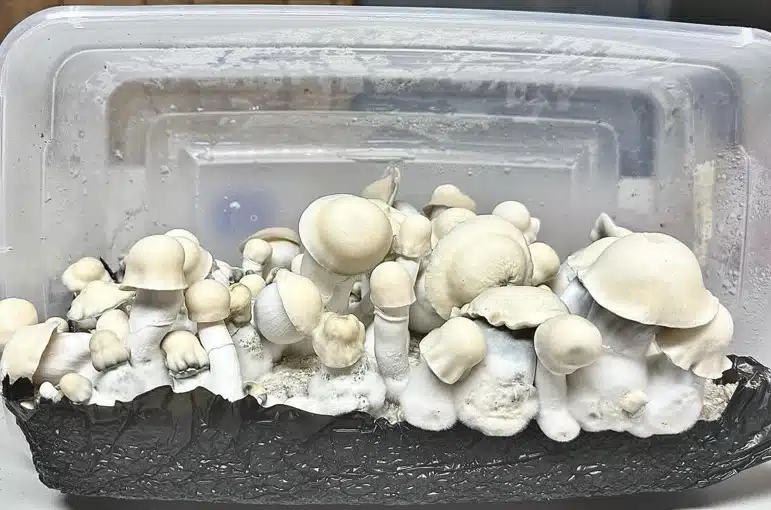Shakti
Shakti Mushroom Information
The Shakti mushroom is a recent albino mutation of the Malabar Coast mushroom originating from Malabar Coast, India. Characterized by its robust stems and firm caps, this mushroom starts with a convex cap that matures into a unique wavy, rigid structure. Notable for its pale coloring, the Shakti mushroom displays distinct bluish bruising. Collecting spores from this strain is challenging due to its wavy cap structure. However, this rarity, coupled with its newness and limited spore production, offers a unique research opportunity for pioneering mycologists.
- Origin: Albino Mutation of Malabar Coast p. Cubensis
- Founder: Unknown
- Potency: Average
- Effects: Euphoria, connectedness, visual stimulation, deep contemplation, and body sensations.
Description
Shakti Mushrooms
Psychedelic mushrooms, commonly referred to as “magic mushrooms,” are a part of a large family of fungi known for their psychoactive compounds, psilocybin, and psilocin. These mushrooms have been used for centuries for religious, healing, and divinatory purposes. Among the diverse variety of Psilocybe mushrooms, the Shakti mushroom strain of P. Cubensis has recently emerged as a notable sub-strain.
Sub-strains are generally categorized by either reginal (p. cubensis growing in varied regions), mutations (isolated mutations), or hybridization (breeding two or more variants to develop a new stable variant). Shakti is an isolated mutation.
Shakti Origin and Appearance
Shakti is a newly discovered albino mutation of the Malabar Coast mushroom that can trace its roots back to Malabar Coast, India. Being a recent variation, much about these mushrooms is still shrouded in mystery. Notable for their robust, broad stems and firm caps, these mushrooms present a fascinating study. The caps begin as a standard convex shape but mature into a wavy, rigid structure that’s truly striking. Both the cap and stem bear an extremely light hue, with the distinctive bluish bruising easily visible due to the mushroom’s unusually pale fruits.
A unique feature of the Shakti mushroom is the distinctive wavy and rigid cap that makes spore collection challenging.
How To Grow Shakti Magic Mushrooms
Shakti are considered average to grow. There are a variety of different ways to grow them, yet, the most beginner-friendly method is to fruit directly from the bag using an all-in-one bag such as this one from Mushroomsupplies.com.- Inoculate grain bag with 3-5cc of Shakti liquid culture or spores via spore syringe.
- Store the inoculated grain bag in a dry area for colonization making sure to maintain a substrate temperature of 84-86. Colonizing mycelium generates its own heat, so an ambient room temperature in the high 70s is recommended.
- Once fully colonized, prepare the tin container and begin layering the substrate and colonized grain. Begin and end with a layer of the substrate.
- Set aside for re-colonization (10-14 days)
- Prepare the lid by adding fresh air holes and cover with micro-pore tape.
- Replace the lid and place the tin into fruiting conditions. Reduce the ambient temperatures to reduce the substrate temperatures to 74-78 degrees F.
- Mist the inside of the chamber lid when needed.
- Harvest
Shakti Magic Mushroom Growing Parameters:
| Preferred Substrate(s): | Various grain types, compost, pasteurized dung/straw |
| Substrate Temperature (Colonization): | 84/86 degrees F. |
| Substrate Temperature (Fruiting): | 74/78 degrees F. |
| Humidity/FAE | During Colonization: 100%RH, 0 FAE: During Fruiting: 90%RH, FAE 2-5x per day |
When is Shakti Ready to Harvest?
Shakti mushrooms are ready to harvest when the veil (the thin membrane beneath the cap) begins to tear. This usually occurs 5–10 days after pinning. Harvest just before or immediately after the veil breaks to prevent spore release, which can reduce potency.
Where to Buy Shakti Liquid Culture
Liquid cultures for Shaktis can be purchased from reputable mycology vendors like MillyWyco, Sporeworks, or SporeStore. Always verify local laws—spores are legal for microscopy in most U.S. states but prohibited in Idaho, Georgia, and California.
Are Shakti Mushrooms Hallucinogenic?
Yes, Shakti’s are a variety of psilocybe cubensis and contain psilocybin, a psychoactive compound.
Are Shakti Mushrooms Legal?
Psilocybin mushrooms are federally illegal in the U.S. and many countries. However, spores are legal for microscopy research in most states. Check local regulations.
Are Shaktis Easy to Grow?
Shaktis are beginner-friendly due to their resilience. Success requires sterile conditions, proper humidity, and patience.
What You Need to Know About Shaktis
What Do Shakti Pins Look Like?
Pins are small, white bumps that form during the early fruiting stage. They resemble tiny mushrooms and grow rapidly once established.
What Substrate is Best for Shaktis?
A mix of coco coir, vermiculite, and gypsum (CVG) is ideal. Pasteurize the substrate to prevent contamination.
What Temperature Do Shaktis Need?
- Colonization: 75–80°F
- Fruiting: 70–75°F
Additional information
| Origin | Unknown |
|---|---|
| Strength | Average |
| Effects | Spiritual, Feelings of Connectedness, Euphoria, Warm Grounded Energy. Great for beginners. |
| Cultivation Difficulty | Easy |
| Founder | Mr. G |


Reviews
There are no reviews yet.